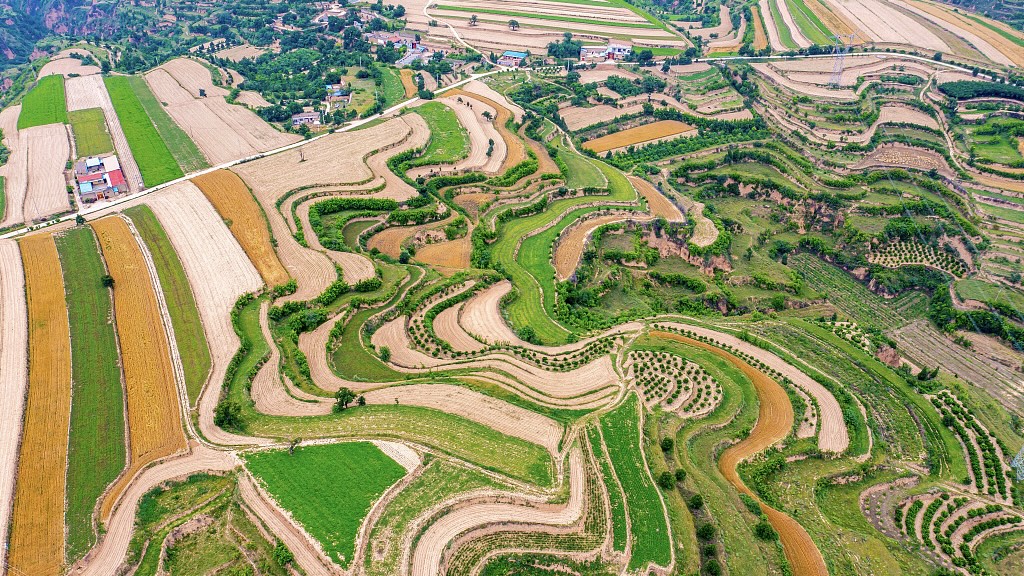
Yuncheng, Shanxi Province. /CFP
Yuncheng, Shanxi Province. /CFP
Editor's note: Si Wei is the dean of School of Economics and Management, China Agricultural University. The article reflects the author's opinions and not necessarily the views of CGTN.
The protection of arable land resources, as an important carrier to support the sustainable operation of the social economy and improve people's dietary nutrition, is a crucial cornerstone for maintaining national food security and coping with complex international situations. President Xi Jinping emphasized that "we must protect arable land like we protect the giant pandas when shouldering the heavy responsibility of ensuring food security." The Chinese government has always regarded arable land protection as a top priority for safeguarding national food security. Since the first amendment of the Land Management Law in 1998, "effectively protecting arable land" has been explicitly specified as one of the fundamental national policies to be persevered with in the long term. In the planning proposal for the "Thirteenth Five-Year Plan," the implementation of the "strictest arable land protection system" and adherence to the "red line" of arable land were explicitly stated. Since the 18th National Congress of the Communist Party of China, the country has established a policy, legal, and regulatory system that is conducive to full-scale arable land protection, with a series of policy measures introduced to optimize the balance between occupation and compensation, contain non-agricultural land use, and prevent non-grain use.
China's strict implementation of farmland protection systems has ensured the preservation of 1.8 billion acres of farmland, while simultaneously designating 1.55 billion acres as permanent basic farmland. This initiative has played an indispensable role in achieving food security for China's population, minimizing the country's dependence on international food sources, and contributing to the stability of global food prices. As of the end of 2022, China had successfully constructed 1 billion acres of high-standard farmland, resulting in a steady grain production capacity of over 1 trillion kilograms. Over half of China's farmland, which totals 1.918 billion acres, is categorized as high-standard farmland. The ongoing reforms aim to facilitate improvements in the farmland protection system for a new era. The responsibility of farmland protection has been comprehensively reinforced, subsequently providing a solid foundation for consistent crop yields, stable economic development, and overall national food security.
The rapid advancement of urbanization and expansion of cities, despite strict farmland protection systems, has led to the illegal occupation of farmland through unauthorized construction and changes in land use, resulting in the loss of farmland. In China's latest round of land surveys in 2019, the farmland area decreased by more than 10 million acres compared to the previous survey in 2009, reflecting a concerning rate of loss. In 2021, the Ministry of Natural Resources, Ministry of Agriculture and Rural Affairs, and National Forestry and Grassland Administration jointly released the Notice on Strict Control of Farmland Use, introducing the concept of a "balance between farmland utilization and non-farmland utilization." For farmland converted to forests, grasslands, or orchards, the policy required a balance between the area of land being removed from cultivation and the area of land being converted to these uses. The policy mandated that all provinces and cities refine control measures and fully implement farmland use control. The "balance between farmland utilization and non-farmland utilization" policy represents a remedial measure for the use of farmland for afforestation, lake digging, landscaping, and agricultural structural adjustment and is an innovative move to prevent a reduction in farmland. The impact of the policy in achieving a balance between farmland utilization and non-farmland utilization has begun to emerge. In 2021, many provincial regions in China experienced a net increase in farmland, with a total net increase of 80,100 hectares in the country, and 19 provincial regions having a net increase in their respective farmland areas.
Under the national strategic guidance of "storing grain in land and technology", we are faced with the challenge of the increasing trend of construction land occupying cultivated land and the increasingly severe form of cultivated land protection. While adhering to the principle of national interests in food security, it is necessary to reserve a reasonable space for the realization of social and individual interests, to better balance the multiple goals of food security, economy, ecology and so on. Therefore, we need to take measures to protect cultivated land. Specifically, the government should continuously increase the subsidy standards for farmers' grain planting, expand the area of grain cultivation, and improve the efficiency of farming, and reduce the phenomenon of cultivated land being converted into non-agricultural land. At the same time, for the "in-out balance" of cultivated land, we should implement the policy of "loose in and strict out," exploring ways to restore cultivated land, expanding cultivated land resources, and strictly controlling the conversion of cultivated land into garden land, forest land, and facilities for agricultural land to reduce the loss of cultivated land. Finally, cultivated land protection should adhere to both quantity and quality, realizing the dual goals of protecting cultivated land and increasing its productivity. We should adopt targeted and comprehensive technological construction to create high-quality fields with good drought resistance, flood control, high yield, and stable production. While protecting the ecological environment of cultivated land, we should implement the policy of "storing grain in land" to lay a solid foundation for ensuring food security.